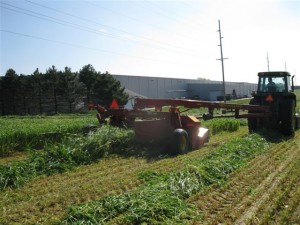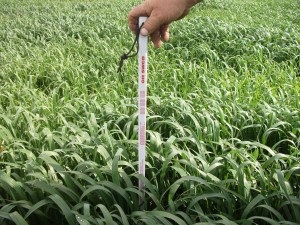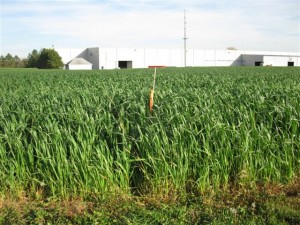– Stan Smith, PA, Fairfield County OSU Extension
This year in Ohio it would seem there were perhaps more oats planted after wheat and into early corn silage harvested acres than in recent memory. Fortunately, the late rains – even though in many cases not abundant – have resulted in excellent yields. Conversations, e-mails and the variety of photos I’ve received support the notion that yield and quality are both good.
As the reports we’re hearing indicate that oats are commonly yielding 2 to 3+ tons of dry matter per acre around Ohio, I’m also being asked about timing and the preferred method of harvest. Unless they were planted 90+ days ago, oats are likely still growing in much of the state. Unless you need the feed immediately, why not let them continue to grow? Oats won’t die until temperatures have been in the mid 20’s for several hours. I’ve not seen any in central/southeast Ohio that have died. That being said, oats will likely remain green and alive for at least a few more weeks.
Certainly if at all possible, strip grazing is the preferred method of harvest. I don’t think I need to review all the reasons. However, realizing that many oats were planted as an afterthought on unfenced fields in an effort to create any amount of late growing forage possible, I’ll review the mechanical harvest alternatives as I see them.
Baling oats in the fall and even into January has been done around Ohio at times in the past, but it’s certainly a challenge considering that oats only dry about half as fast a grass hay. In fact, I’m finding that with the recent precipitation it’s taking nearly a week after being cut before they are even dry enough to properly wet-wrap and ensile. Dropping them on wet soils doesn’t enhance the drying or curing process. Wet-wrapping is also a relatively expensive alternative. Using an in-line bale wrapper/tuber is a little less expensive per ton than individually wrapped bales if the equipment is available locally, but unless done properly might result in more storage loss than wet wrapping individual bales.
Another alternative might be to let the oats stand until they finally freeze, let them dry out while still standing. If/when a few days of dry frozen weather in January arrives, mow them, rake them and bale them quickly after they’ve essentially dried and cured while standing.
In Canada, growers have sprayed their oats with glyphosate and let them dry out while standing. Then, after a few weeks and at a time when they get a dry week, they mow, rake and bale them all in a day or two. Locally, that’s been done once that I’m aware of, which allowed the oats to be baled in late December and January.
If grazing standing oats is simply not an option, perhaps chopping and ensiling them is the best alternative that remains for harvest. This offers several advantages over baling or wet wrapping. Obviously the issue of curing the plants for dry harvest becomes a moot point. Chopping and ensiling into either a permanent structure or bags is also likely less expensive than wet wrapping individual bales. Perhaps even better, as detailed by Francis Fluharty a few years ago in this publication, chopped forages are 30+% more digestible than long stem forages.
Admittedly chopping and ensiling is likely more expensive than rolling dry hay, but when you consider you get essentially no storage losses, the timeliness of harvest which is afforded, and the more digestible feed which results, it’s a good alternative. And if you’re able to bunk feed the chopped and ensiled oats, there will be no “bale ring” feeding losses to be experienced.





